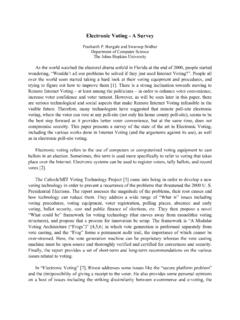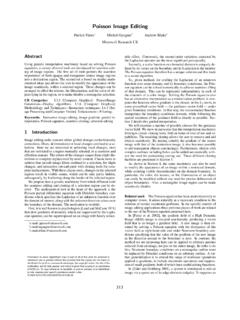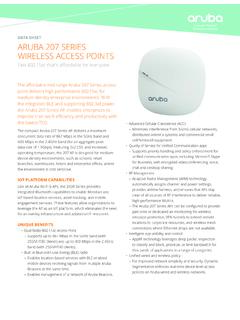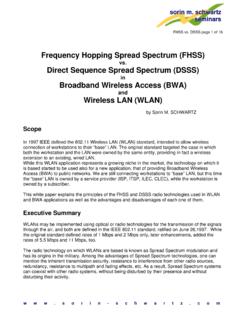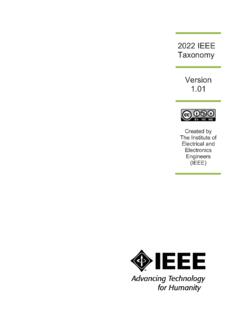Transcription of Introduction to Ad hoc Networks - Department of …
1 1-1 Introduction to Ad hoc NetworksCS-647: Advanced Topics in Wireless NetworksDrs. Baruch Awerbuch & Amitabh MishraDepartment of Computer ScienceJohns Hopkins University Amitabh Mishra & Baruch Awerbuch 20081-2 Outline What is an ad hoc network ? Challenges facing ad hoc Networks History of Ad hoc Networks General Concepts Introduction to IEEE Physical Layers of C. K. Toh, Chapter 3, Ad Hoc Wireless Networks , Prentice Hall, 2002 D. P. Agrawal and Qing-An Zeng, Chapter 13, Wireless & Mobile Systems , Thompson/Brooks Cole, 2003 Refer one of the suggested textbooks1-4 Types of Wireless Networks : infrastructure vs. ad-hoc networksinfrastructurenetworkad-hoc networkAPAPAP wired networkAP: Access Point Infrastructure Networks Fixed, wired backbone Mobile communicates directly with access points Suitable for locations where access points can be placed Cellular networks1-5 Cellular Networks UMTS (3G)UMTS Core NetworkCircuit Switched NetworkUTRANMAPGiIuISUPGSM NetworkSS7 NetworkPacket Data Network1-6 Why Ad Hoc Networks ?
2 Ease of deployment Speed of deployment Decreased dependence on infrastructure1-7 What is an Ad hoc network ? A network without any base stations infrastructure-less or multi-hop A collection of two or more devices equipped with wireless communications and networking capability Supports anytime and anywhere computing Two topologies: Heterogeneous (left) Differences in capabilities Homogeneous or fully symmetric (Right) all nodes have identical capabilities and responsibilitiesHomogeneous network infrastructurenetworkad-hoc networkAPAPAP wired networkAP: Access Pointinfrastructurenetworkad-hoc networkAPAPAP wired networkAP: Access Point1-8 Mobile Ad Hoc Networks ?1-9 Mobile Ad Hoc Networks ? Mobility causes route changes1-10 What is an Ad hoc network ? Self-organizing and adaptive Allows spontaneous formation and deformation of mobile Networks Each mobile host acts as a router Supports peer-to-peer communications Supports peer-to-remote communications Reduced administrative cost Ease of deployment infrastructurenetworkad-hoc networkAPAPAP wired networkAP: Access Pointinfrastructurenetworkad-hoc networkAPAPAP wired networkAP: Access Point1-11Ad Hoc Networks Operating Principle Fig.
3 Depicts a peer-to-peer multihop ad hoc network Mobile node A communicates directly with B (single hop) when a channel is available If Channel is not available, then multi-hop communication is necessary A->D->B For multi-hop communication to work, the intermediate nodes should route the packet they should act as a router Example: For communication between A-C, B, or D & E, should act as routersExample of an Ad Hoc network ABCDEABCDE1-12 Bringing up an Ad hoc hoc network begins with at least two nodes broadcasting their presence (beaconing) with their respective address may also include their location info if GPS messages are control messages. If node A is able to establish a direct communication with node B verified by appropriate control messages between them, they both update their routing tablesABCDEABCDE1-13 Bringing up an Ad hoc Network4. Third node C joins the network with its beacon signal. Two scenarios are possible:(i) A & B both try to determine if single hop communication is feasible (ii) Only one of the nodes B tries to determine if single hop communication is feasible and establishes a connectionABCDEABCDE1-14 Bringing up an Ad hoc distinct topology updatesconsisting of both addressand the route updatesare made in three nodes first scenario, all routes are direct A->B, B->C, and A->C (Lets assume bi-directional links)
4 ABCDEABCDE1-15 Bringing up an Ad hoc network In the second scenario, the routes are updated between B & C, between B & A, between B & C again confirming that A and C both can reach each other via BCBA[topologyupdate][topologyupdate][top ologyupdate][topologyupdate]CBA1-16 Topology Update Due to a Link Failure Mobility of nodes may cause link breakage requiring route updates Assume link between B & C breaks because of some reason Nodes A & C are still reachable via D and E So old route between A &C was A->B->C is to be replaced by A->D->E->C All five nodes are required to incorporate this change in their routing table This change will happen first in nodes B & C Then A & E Then DABCDEABCDE1-17 Outline What is an ad hoc network ? Challenges facing ad hoc Networks History of Ad hoc Networks General Concepts Introduction to IEEE Physical Layers of Characteristics Traffic characteristics may differ in different ad hoc Networks bit rate timeliness constraints reliability requirements unicast / multicast / geocast host-based addressing / content-based addressing / capability-based addressing May co-exist (and co-operate) with an infrastructure-based network1-19 Traffic Profiles Three distinct types of traffic patterns observed in ad hoc Networks Peer-to-peer between two entities (Fig.)
5 A) Bursty Two or more devices in a group communication while moving as a group (correlated traffic) -> remote to remote communication Hybrid non-coherent communication among nodes -> uncorrelated traffic1-20 Challenges in Ad hoc Mobile Networks (1) Host is no longer an end system - can also be an acting intermediate system Changing the network topology over time Potentially frequent network partitions Every node can be mobile Limited power capacity Limited wireless bandwidth Presence of varying channel quality1-21 Challenges in Ad hoc Mobile Networks (2) No centralized entity distributed How to support routing? How to support channel access? How to deal withmobility? How to conserve power? How to use bandwidthefficiently?1-22 Problems Facing Routing in Ad hoc Networks Routers are now moving Link changes are happening quite often Packet losses due to transmission errors Event updates are sent often a lot of control traffic Routing table may not be able to, converge Routing loop may exist Current wired routing uses shortest path metric1-23 Problems facing channel access in Ad hoc Networks Distributed channel access.
6 No fixed base station concept Very hard to avoid packet collisions Very hard to support QoS Early work on packet radio is based on CSMA1-24 Problems of Mobility in Ad hoc Mobility affects signal transmission -> Affects communication Mobility affects channel access Mobility affects routing Mobility-induced route changes Mobility-induced packet losses Mobility affects multicasting Mobility affects applications1-25 Mobility in Ad hoc Networks Mobility patterns may be different people sitting at an airport lounge New York taxi cabs kids playing military movements personal area network Mobility characteristics speed predictability direction of movement pattern of movement uniformity (or lack thereof) of mobility characteristics among different nodes1-26 Problems of Power in Ad hoc Ad hoc devices come in many different forms Most of them battery powered Battery technology is not progressing as fast as memory or CPU technologies Wireless transmission, reception, retransmission, beaconing, consume power!
7 Quest for power-efficient protocols Quest for better power management techniques1-27 Research on Mobile Ad Hoc Networks Variations in capabilities & responsibilities Variations in traffic characteristics, mobility models, etc. Performance criteria ( , optimize throughput, reduce energy consumption) Increased research funding -> Significant research activity1-28 Outline What is an ad hoc network ? Ad hoc network Applications Challenges facing ad hoc Networks History of Ad hoc Networks General Concepts Introduction to IEEE Physical Layers of Radio First Ad hoc network Packet switching was demonstrated by the ARPANet in the 1960 Key Advantage - Dynamic sharing of bandwidth among multiple users DARPA initiated a packet radio network (PRNet) research in 1972 recognizing packet switching PRNet was to provide an efficient means of sharing broadcast radio channel among many radios1-30 Architecture of PRNETsThe network architecture of PRNETs, which comprises mobile devices/terminals, packet radios, and repeaters.
8 The static station is Packet Radio Networks -Characteristics Presence of mobile repeaters Mobile terminals Static station for routing Technology ahead of time Not entirely infrastructureless1-32 PRNet Mobile repeater relays packet from one repeater to other until the packet makes it to destination Bellman Ford (Distance-Vector) type of routing algorithm running in a static station Static station has complete topology Routing table broadcasted to each terminal Shortest delay path for every destination in the network available to every terminal1-33 PRNet Periodic update for route changes ACK based flow control and recovery from errors CSMA based MAC Low mobility Low throughput (2 kbps per subscriber)1-34 The interface of a data terminal to a packet radio The user computer interfaced to radio via terminal network controller (TNC) LSI based therefore bulky architecture TNC and Radio constitute packet radio that handles layer 1 to layer 3 functionalities Now a laptop integrates packet radio within itself due to VLSI1-35 Outline What is an ad hoc network ?
9 Ad hoc network Applications Challenges facing ad hoc Networks History of Ad hoc Networks General Concepts Introduction to IEEE Physical Layers of Concepts (1) DuplexingChoices The duplexing mechanism refers to how the data transmission and the reception channels are multiplexed: Can be multiplexed in different time slots Can be multiplexed in different frequency bands Time Division Duplex (TDD) refers to multiplexing of transmission and reception in different time periods in the same frequency band Frequency Division Duplex (FDD) refers to using different frequency bands for uplink and downlink transmissions FDD Its possible to send and receive data simultaneously TDD Its not possible to send and receive data simultaneously1-37 General Concepts (3) network Architecture Distributed Wireless Networks Ad hoc Networks fall in this category Wireless nodes communicating with each other without any fixed infrastructure Terminals have an RF or infrared interface All data transmission and reception in the same frequency band (there is no special node to do the frequency translation) All ad hoc Networks operate in TDD mode No centralized control for managing the network node failures Concepts (4)
10 network Architecture Centralized Wireless Networks Cellular Networks fall in this category Also called last-hop Networks Wireless nodes communicating with each other using fixed infrastructure (Base Station) Base station acts as an interface to the wire-line Networks Downlink transmission is broadcast all nodes in the BS coverage can hear the transmission 1-39 General Concepts (5) network Architecture Centralized Wireless Networks Uplink transmission is shared among nodes so its multiple access Can operate in both the TDD or FDD mode Centralized control for managing the network BS provides flexibility in MAC design (admission control, scheduling, QoS provisioning etc.)1-40 General Concepts (6) Slotted Systems A wireless channel is said to be slottedif transmission attempts can take place at discrete instants in time A slotis the basic time unit large enough to carry the smallest packet with overhead(header + guard band) A slotted system requires network wide synchronization Base station facilitates it by acting as a time reference Synchronization is difficult in Ad hoc Networks1-41 Outline What is an ad hoc network ?


